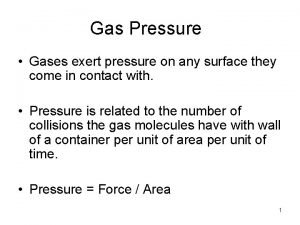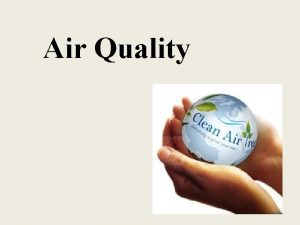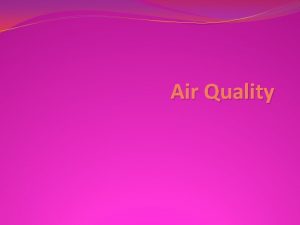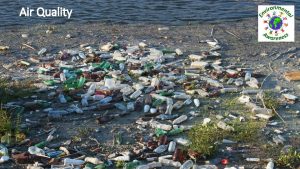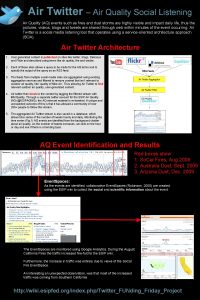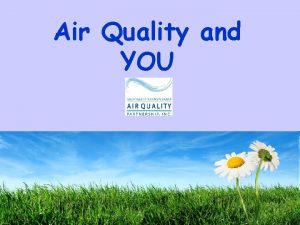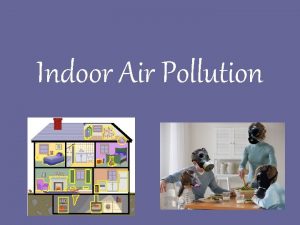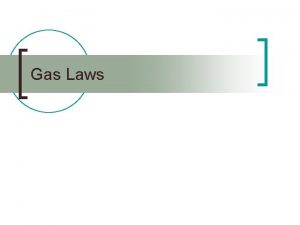Air Quality Air is the gas that surrounds













- Slides: 13

Air Quality

• Air is the gas that surrounds the earth and makes it possible for plants and animals to live. • It is made up of nitrogen and oxygen, with small amounts of carbon dioxide, hydrogen and helium.

• Because air is important to our survival, we need to monitor what things are going into the air. • Danger to human health can be significant – for example, fine particles kill approximately 400 people a year in Sydney (Source: CSIRO Department of Atmospheric Research).

• Air quality monitoring is about measuring the amounts of pollutants in the air and comparing the results against a standard, so that we can identify when air pollution is at a dangerous level, then take action.

What is air pollution and where does it come from? Ø Air pollution happens when unwanted gases, dust, or fumes get into the air. In Australia the main contaminants of outside air are: • carbon monoxide, nitrogen oxides and hydrocarbons from vehicle exhausts; • ozone (generated when oxides of nitrogen and hydrocarbon compounds react in the presence of sunlight); • sulphur dioxide (from industrial processes); • microscopic particles (formed from combustion).

• Other contaminants include lead (from vehicle exhaust and smelters), and volatile organic compounds (from vehicles, fuel combustion, and solvents).

• The car is the biggest single source of air pollution in Australia. • Other sources include industry and various smaller sources (backyard incinerators, fires, chemicals etc. ). • The majority of our air pollution problems are caused by our own activities, and the machines and chemicals that we use everyday. • Some air pollutants come from natural sources such as volcanic eruptions, dust storms, bushfires or plant pollen. (Source: CSIRO Department of Atmospheric Research)

Environmental impacts of air pollution

The Greenhouse Effect • The greenhouse effect is a term used to describe the natural warming process that takes place as the sun’s energy is absorbed by the earth. • Greenhouse gases in the atmosphere act as insulation to keep the heat from radiating out into space. Without this, the earth’s average surface temperature would be about 33°C cooler. • The main sources of these greenhouse gases are fossil fuel combustion and industrial processes.

The Ozone Hole • The ozone layer in the stratosphere (mostly between 15 and 30 kilometres above the earth’s surface) is essential because it screens out about 90% of ultraviolet radiation from the sun. • In spring each year above Antarctica, the ozone layer becomes very thin and is referred to as the ozone hole. • Ozone depletion is due to chemical emissions from industrial activity. Chlorofluorocarbons (CFC’s) are the main pollutant responsible for destroying the ozone layer.

Acid Rain • Acid rain is formed when nitrogen oxides and sulfur dioxide react with moisture to form nitric and sulfuric acids. • This makes rain more acidic than normal (pure rainwater is usually only slightly acidic). • Acid rain can harm plants, contribute to soil acidity, pollute waterbodies, and damage buildings by eroding stone and concrete.

The role of plants in air quality • Plants play a critical role in maintaining good air quality. Through photosynthesis, plants take up carbon dioxide and transform it into oxygen and water vapour. • Carbon is stored in plant tissues. • The role of plants as ‘carbon sinks’ is being used by industry to offset their carbon emissions. For example, some energy companies are paying the State Forests of New South Wales to plant and manage forests on land leased from local farmers. In return, they get tradeable emission credits.

Air Pollution In groups brainstorm one of the following impacts of air pollution: • Air pollution impacts on health • Air pollution impacts on ecosystem (plants and animals) • Air pollution impacts on Property • Air pollution impacts on Economy Definition Problem Causes Effects Solution
 Phân độ lown ngoại tâm thu
Phân độ lown ngoại tâm thu Block xoang nhĩ ecg
Block xoang nhĩ ecg Thể thơ truyền thống
Thể thơ truyền thống Thơ thất ngôn tứ tuyệt đường luật
Thơ thất ngôn tứ tuyệt đường luật Chiến lược kinh doanh quốc tế của walmart
Chiến lược kinh doanh quốc tế của walmart Tìm vết của mặt phẳng
Tìm vết của mặt phẳng Con hãy đưa tay khi thấy người vấp ngã
Con hãy đưa tay khi thấy người vấp ngã Tôn thất thuyết là ai
Tôn thất thuyết là ai Gây tê cơ vuông thắt lưng
Gây tê cơ vuông thắt lưng Sau thất bại ở hồ điển triệt
Sau thất bại ở hồ điển triệt Pt tanah air sentosa
Pt tanah air sentosa From all the evil that surrounds me
From all the evil that surrounds me Do gases exert pressure on whatever surrounds them
Do gases exert pressure on whatever surrounds them Everything that surrounds us
Everything that surrounds us












